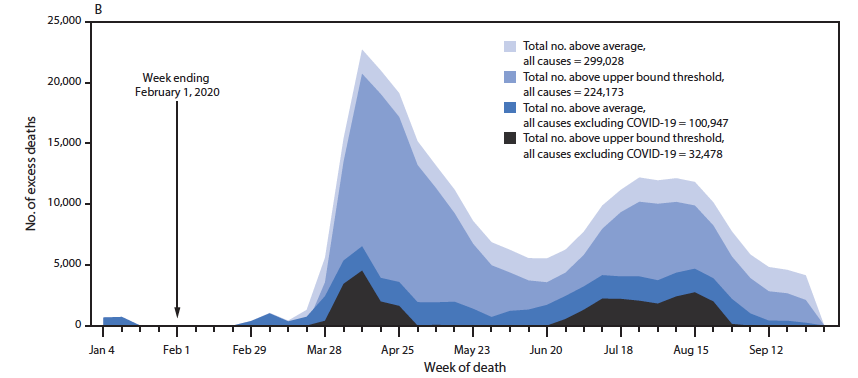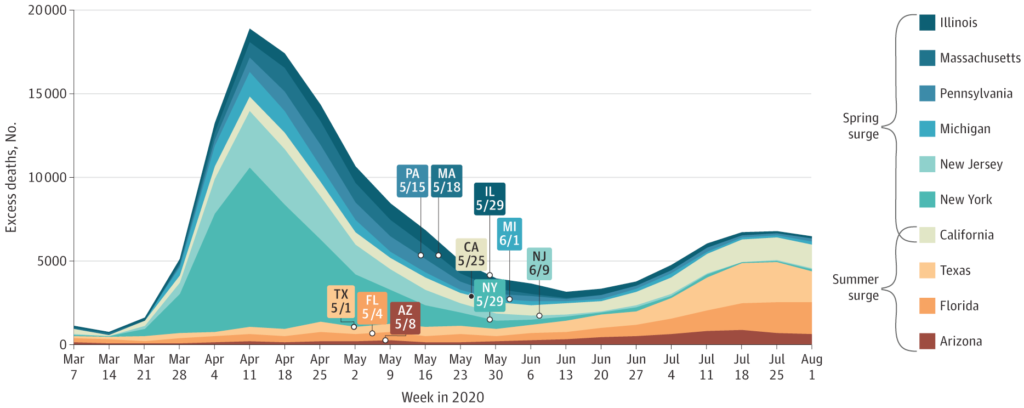Q: Are we OVER or UNDER counting COVID-19 deaths? Wouldn’t a lot of these people have died anyway?
A: The death toll has been HIGH.
We are likely UNDER counting deaths due to COVID-19.
While some deaths attributed to COVID-19 would have occurred during this period anyway, we have a way to account for this in our metrics by calculating what we call “EXCESS MORTALITY” – the number of deaths above and beyond those that would have been expected based on previous years.
We know that relying on deaths that are coded as COVID-19 may not be entirely accurate. Early in the pandemic, testing was less common and thus COVID-19 deaths may have been missed and coded as something else. Some also worried that COVID-19 has been over-used on death certificates for people who were dying of other conditions.
“Excess mortality” gets around these challenges by counting ALL deaths, no matter what is recorded on the death certificates, and comparing these to a baseline of the average number of deaths over the same time period in previous.
The benefit of “excess mortality” is that it likely picks up “direct” COVID-19 related deaths that were not registered as such, especially early on when testing rates were low. It will also pick up any “indirect” deaths that may have happened due to the impact of the pandemic on overwhelmed hospitals or being deterred from seeking out needed health care.
The CDC just released new data on excess mortality in 2020 in the US, calculating that *299,028* excess deaths have occurred from late January up to October 3rd. Of these, only 198,081 were officially recorded as COVID-19 deaths, meaning the true COVID-19 death toll may be up to 50% higher than official deaths.
While the highest absolute number of excess deaths was in the 75-84 year old age group (94, 646) one unexpected finding was that the 25-44 age group saw the highest *percentage* increase in deaths (26.5%) compared to previous years, belying the notion that younger adults are not at risk from COVID-19.
Sadly, the excess death numbers also reflect observed race/ethnic differences in COVID-19 mortality, with Hispanics having the highest percentage increase in excess deaths (53.6%).
In one piece of good news, numbers of deaths among persons aged <25 years were 2.0% below average, which may reflect lower risk of accidental death during this time.
What did people die of that was not recorded as COVID-19? How do we know if these were actually due to COVID-19? Deaths from circulatory diseases, Alzheimer disease and dementia, and respiratory diseases increased in 2020 relative to past years.
While we can’t know for sure to what extent these represent misclassified COVID-19 deaths or deaths indirectly related to the pandemic (e.g., because of disruptions in health care access or utilization), the timing and geographical pattern of excess mortality has closely tracked the progression of the virus itself rather than lockdown restrictions (see figures).
BOTTOM LINE:
For those who are worried about over-counting of COVID-19 deaths in hospitals or counting people who happened to get COVID-19 but were going to die soon anyway…
EXCESS mortality accounts for this and only counts deaths ABOVE AND BEYOND WHAT IS EXPECTED, so it gives us the most accurate picture of the mortality burden due to COVID-19.
It is clear that this mortality burden is HIGH and has tracked the timing and geographical footprint of the virus itself.
Winter is coming dear followers, Stay Safe and Stay Sane!
Love,
Those Nerdy Girls
Further resources:
Excellent article on excess mortality during the pandemic
Financial Times for estimates of excess mortality globally
Excess mortality in the US through August 1st by State
Excess deaths by U.S. State (through Sept 5th)
Our World in Data Primer on Excess Mortality





